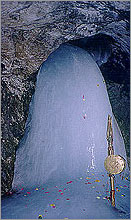|
|

 With
places of Worship like Hazratbal Shrine, Amarnath Cave, Shankaracharya
temple, Dastgir Sahib, Hazrat Sultan Arfeen, Khirbawani temple,
Chaati-Paadshaahi, Mata Vaishno Devi temple, Rozabal shrine (tomb
of Jesus Christ), Hemis and Phyang monasteries makes the state of
Jammu, Kashmir & Ladakh a diverse, ethnic and cultural make
up of the Indian Society. Hindus, Muslims, Sikhs, Christians and
Buddhists live lives intertwined in the same Cultural Fabric. With
places of Worship like Hazratbal Shrine, Amarnath Cave, Shankaracharya
temple, Dastgir Sahib, Hazrat Sultan Arfeen, Khirbawani temple,
Chaati-Paadshaahi, Mata Vaishno Devi temple, Rozabal shrine (tomb
of Jesus Christ), Hemis and Phyang monasteries makes the state of
Jammu, Kashmir & Ladakh a diverse, ethnic and cultural make
up of the Indian Society. Hindus, Muslims, Sikhs, Christians and
Buddhists live lives intertwined in the same Cultural Fabric.
The
Amarnath Yatra
The Pilgrimage
to Amaranth, in the month of Sharavan (July - August) has the devote
flock to this incredible shrine, where the image of Shiva, in the
form of a lingam, is formed naturally of an ice-stalagmite, and
which waxes and wanes with the moon. By its side are, fascinatingly,
two more ice -lingams, that of Parvati, and their son, Ganesha
.
Situated in a narrow gorge at the farther end of Lidder valley,
Amaranth stands at 3,888 m and is 46 km from Pahalgam and 141 km
from Srinagar.
The Second
approach to the Amarnath Cave is from Sonamarg via Baltal. BALTAL,
which is a little charming valley lying in the foothills of Zojila
Pass. The Holy Cave of Amarnath Ji is just a day’s journey
away from here. The trail from Baltal to the Holy Cave lies along
very steep hillsides. Several snow bridges on the fast flowing streams
have to be crossed over, while during the Holy Cave is quite near,
the trail from Pahalgam meets the Baltal route.
Mata
Vaihno Devi Pilgrimage
The cave
shrine of Mata Vasihnodeviji or Trikuta Bhagwati (alt: 5,200 ft.)
has been a beacon of faith and fulfillment to millions of devotees
from all over the world. The pilgrimage to the Shrine holds great
significance for the pilgrims. Everyday of the year throngs of people
surge up the steep pathways that cut across the Trikuta hillsides
for mile after mile. This show of faith is finely interwoven with
the cultural strands of the Indian subcontinent, and these pathways
have been trod on for many centuries now. Popular belief holds that
anybody who walks the Himalayan trail to the goddesses's abode to
ask for a boon rarely goes back disappointed. There are many who
journey year after year to pay obeisance regardless of their faith
or belief, creed or class, caste or religion.
Hazratbal
Shrine
This unmatched
reverence is anchored in the love and respect for the Prophet Mohammad
(Peace be upon him), whose Moi-e-Muqqadas, (the sacred hair or Holy
Relic) is preserved here. This is displayed to the public on religious
occasions, usually accompanied by festivals.
Kheer
Bhawani
The Goddess
Ragnya Devi is symbolised, as a sacred spring at Tula Mula Within
the spring is a small marble temple. The devotees of the goddess
fast and gather here on the eighth day of the full moon in the month
of May when, according to belief, the goddess changes the colour
of the spring's waters.
Martand
Martand, located atop a plateau, close to the township of Anantnag,
has a temple dedicated to Surya, the "Sun God". Built
by king Laitaditya Muktapida (7th to 8th century AD), it is a medieval
temple with a colonnaded courtyard and the shrine in its centre.
The temple complex has 84 columns and offers a commanding view of
the valley of Kashmir.
Sindu
Darshan
The mighty
Sindhu (Indus) River symbolizes the power and permanence of the
ancient Indian civilization, which evolved over a period of thousands
of years. The archaeological discovery of the Indus Valley civilization,
which flourished along its banks, has reinforced the antiquity of
the Indian civilization. The journey of Sindhu (also spelt as Sindhu)
through India transports one to a civilization going back 5,000
years. The Indus Valley civilization is synonymous from Harappa
and Mohenjodaro.
Sindhu is divine. In the beginning was the word. The first recorded
word was the Veda. The earliest mention of this great river is in
the Vedas. The Sindhu - the cradle of Indian civilisation - finds
its most dramatic description in the Rig Veda (circa.1500 BC).
The Sindhu
Darshan or Sindhu Festival aims at projecting the Indus as a symbol
of India's unity and communal harmony. Sindhu stands for peaceful
coexistence and communal harmony. The Sindu Darshan Piligrimage
is done on June. |


